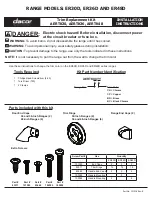
13
Induced current can be created only in
materials which have magnetic properties.
Thus, utensils for use with an induction unit
must be made from a ferromagnetic material
or have inserts with magnetic properties.
Your household may already have cookware
suitable for induction cooking, and you may
test any utensil with an induction element.
Incorporated controls are able to recognize
a suitable utensil. To perform a utensil test:
- Turn an element on and adjust power to any
level - you will notice that the digital power
display is flashing.
- Place your utensil on the coil. If the piece
being tested is suitable for induction
cooking, the display will become steady.
However, if it keeps flashing, the utensil
cannot be used on your induction unit.
- If the utensil is empty, remove it from the
coil immediately after you have done test and
turn the element OFF.
Another simple test to determine if a piece of
cookware can be used on an induction
cooktop is the ‘magnet test’. Use a magnet
and place it on the utensil. If the magnet
sticks to it, the piece will work with
induction.
Utensils for Your Induction
Utensils ccompatible w
with iinduction aare:
• Cookware made of enamel coated steel
with or without a non-stick coating.
• Cast iron cookware with or without enamel
coated base.
• Stainless steel pots and pans designed for
induction cookware.
Note:
Stainless steel used for utensils is non-
magnetic, in most cases, and unsuitable for
Utensils with thick flat bases should be chosen for the benefit of uniform heat
distribution.
Never leave an empty piece of cookware on an induction heating element for more then a few
seconds. If a utensil is left on an element at full power, temperature of the dish may
increase rapidly, the safeties would not engage, and this may damage your utensil,
the cooktop, and could result in an injury or a damage to your property.
When cooking large quantities of food, it is
always better to use a large diameter pan
and a larger coil, thus better and more
efficient heat distribution will be achieved
and food cooked evenly.
Matching P
Pots &
& P
Pans w
with C
Coils, eetc.
Small elements,16 cm (6 1/2”), are best
utilized:
- With small utensils - but normally not
smaller then 10 cm (4”);
- For slow cooking and simmering (sauces,
creams, etc.);
- For cooking small quantities of food.
Large elements, 22 cm (9”), are primarily
designed for day-to-day cooking needs and
most commonly used pans - 18 to 25 cm (7
to 9 1/2”) in diameter.
induction cooking, but most manufacturers
make such utensils in layers for better heat
distribution, and a good number of such
pots and pans can be used with induction.
To make sure if a stainless steel utensil can
be used perform the utensil test.
Use of utensils with enameled coated base
will prevent the glass top of your unit from
getting scratched.
Pots and pans which do not have a flat
bottom still may be used, however they
should not be overly deformed.
Cookware made from glass, ceramic,
earthenware, aluminum and copper pots and
pans and non-magnetic stainless steel
cookware are not suitable for induction
cooking.




































